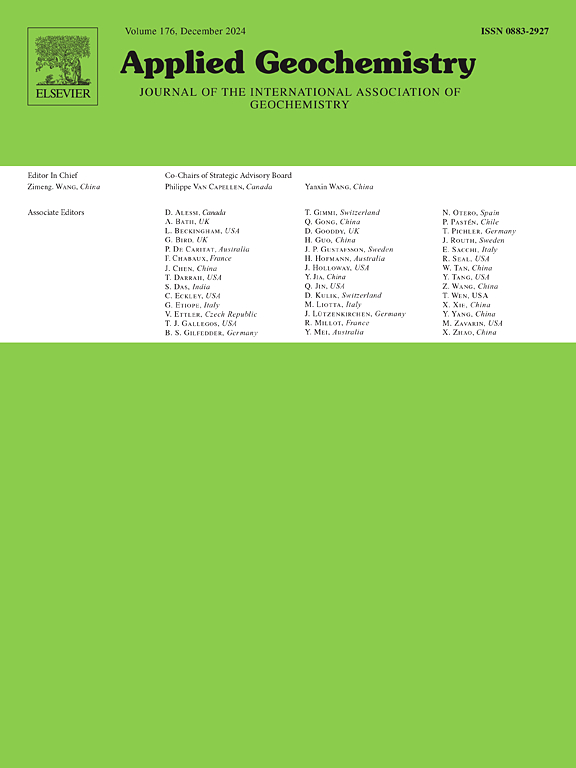Distribution and leachability of heavy metals from lead-zinc tailings with different degrees of chemical weathering in the Qinling Mountains
IF 3.4
3区 地球科学
Q1 GEOCHEMISTRY & GEOPHYSICS
引用次数: 0
Abstract
The Qinling Mountains in Shaanxi Province are one of China's most significant ecological reserves, but many lead-zinc tailings have been produced during decades of mining development. The heavy metals in these lead-zinc tailings pose a severe pollution risk to the surrounding areas. However, the vertical distribution, leaching behaviour and ecological risk of heavy metals in these tailings remain unclear. A lead-zinc tailings profile from the southeast foot of the Qinling Mountains was studied. The particle size, chemical composition, mineralogy, micromorphology, Nemerow pollution index and leaching behaviour were analysed. The results showed that the lead-zinc tailings profile had an intermediate chemical weathering layer (depth 0–70 cm) and an incipient chemical weathering layer (depth 70–100 cm). Quartz and muscovite were the main minerals. The intermediate chemical weathering layer was more enriched in Cr and Pb, while the incipient chemical weathering layer was more enriched in Cd and Zn. The final leaching concentrations of Cr, Cd, Zn and Pb in the incipient and intermediate chemical weathering layers after 50 days were very similar, at 0.27–0.36, 0.60–0.81, 6.93–9.03 and 7.81–10.47 mg L−1, respectively. However, the average leaching efficiency was the reverse. Calcite and chemical weathering intensity may have been connected to this. The lead-zinc tailings were highly polluted, with Pb, Zn, Cd and As being the main pollutant elements. In summary, this study provides new insights for controlling heavy metal migration and mitigating environmental hazards in existing lead-zinc tailings ponds in the Qinling Mountains.
秦岭不同化学风化程度铅锌尾矿中重金属的分布及可浸性
陕西秦岭是中国最重要的生态保护区之一,但在数十年的矿山开发过程中产生了大量的铅锌尾矿。这些铅锌尾矿中的重金属对周边地区构成了严重的污染风险。然而,重金属在尾矿中的垂直分布、浸出行为和生态风险尚不清楚。对秦岭东南山脚某铅锌尾矿剖面进行了研究。对其粒度、化学成分、矿物学、微观形貌、内梅罗污染指数和浸出行为进行了分析。结果表明:铅锌尾矿剖面存在中间化学风化层(深度0 ~ 70 cm)和早期化学风化层(深度70 ~ 100 cm);石英和白云母是主要矿物。中期化学风化层富集Cr、Pb,早期化学风化层富集Cd、Zn。50 d后,初期和中期化学风化层Cr、Cd、Zn和Pb的最终浸出浓度基本一致,分别为0.27 ~ 0.36、0.60 ~ 0.81、6.93 ~ 9.03和7.81 ~ 10.47 mg L−1。而平均浸出效率则相反。方解石和化学风化强度可能与此有关。铅锌尾矿污染严重,铅、锌、镉、砷是主要污染元素。综上所述,本研究为控制秦岭既有铅锌尾矿库重金属迁移和减轻环境危害提供了新的思路。
本文章由计算机程序翻译,如有差异,请以英文原文为准。
求助全文
约1分钟内获得全文
求助全文
来源期刊

Applied Geochemistry
地学-地球化学与地球物理
CiteScore
6.10
自引率
8.80%
发文量
272
审稿时长
65 days
期刊介绍:
Applied Geochemistry is an international journal devoted to publication of original research papers, rapid research communications and selected review papers in geochemistry and urban geochemistry which have some practical application to an aspect of human endeavour, such as the preservation of the environment, health, waste disposal and the search for resources. Papers on applications of inorganic, organic and isotope geochemistry and geochemical processes are therefore welcome provided they meet the main criterion. Spatial and temporal monitoring case studies are only of interest to our international readership if they present new ideas of broad application.
Topics covered include: (1) Environmental geochemistry (including natural and anthropogenic aspects, and protection and remediation strategies); (2) Hydrogeochemistry (surface and groundwater); (3) Medical (urban) geochemistry; (4) The search for energy resources (in particular unconventional oil and gas or emerging metal resources); (5) Energy exploitation (in particular geothermal energy and CCS); (6) Upgrading of energy and mineral resources where there is a direct geochemical application; and (7) Waste disposal, including nuclear waste disposal.
 求助内容:
求助内容: 应助结果提醒方式:
应助结果提醒方式:


